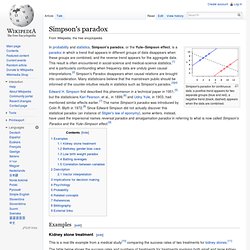

Top 20 Logical Fallacies. Introduction to Argument Structure of a Logical Argument Whether we are consciously aware of it or not, our arguments all follow a certain basic structure.

They begin with one or more premises, which are facts that the argument takes for granted as the starting point. Simpson's Paradox. Simpson's paradox for continuous data: a positive trend appears for two separate groups (blue and red), a negative trend (black, dashed) appears when the data are combined.

In probability and statistics, Simpson's paradox, or the Yule–Simpson effect, is a paradox in which a trend that appears in different groups of data disappears when these groups are combined, and the reverse trend appears for the aggregate data. This result is often encountered in social-science and medical-science statistics,[1] and is particularly confounding when frequency data are unduly given causal interpretations.[2] Simpson's Paradox disappears when causal relations are brought into consideration. Many statisticians believe that the mainstream public should be informed of the counter-intuitive results in statistics such as Simpson's paradox.[3][4]